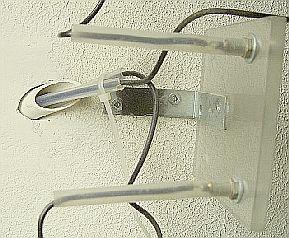
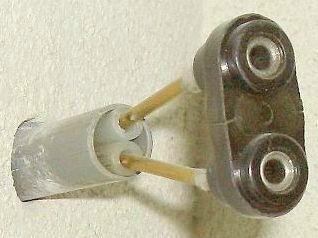
Examples of how it can be done in a simple way.
FEEDER THROUGH WALL


Examples of how it can be done in a simple way.
FEED-THROUGH

Pre-drill first.
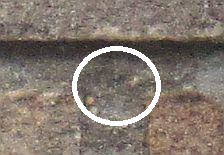
It is often thought that passing an open line through a wall is difficult. You can see a simple solution here.
First pre-drill the outside diagonally upwards in a joint («fig) with, for example, an 8 mm drill of sufficient length. This method prevents rainwater or condensation from entering. Then use a drill of the desired (16mm) diameter. Remove the 16 mm drill regularly to allow the cuttings to drain, otherwise you run the risk of the drill jamming and almost impossible to get out. An expert recently advised not to pre-drill and not to use an impact drill, but to make the hole directly with a good quality 16mm drill bit. When the 8 mm drill has made the hole, there will probably be a piece of plaster on the floor on the inside. To prevent this with the larger drill, first drill a larger hole on the inside with it.
If you move house, the outside hole can be closed well with joint cement and inside, for example, can be finshed off with plaster.
Remove insulation and shielding from a suitable coaxial cable (e.g. H100) and thake out the inner conductor, leaving a hollow tube. Install two equal tubes in the installation pipe. Run the open line through the tubes. The insulation of a pipe with respect to the inner conductor is approximately 5 kV. With two next to each other, that's even more. Teflon tube can also be used instead of the pipes. 3 mm brass welding wire also goes through the tubes and then the open line can be attached to it on the outside. In the photo at the top right, two brass welding rods were used as inner conductor.
When I leave my radio room (shack), I always disconnect all antennas, which is why you see two sockets in the photo. Interrupting the antennas or power lines outside the wall is probably better or safer but I've been doing it on the inside all my amateur life. If it is not possible to remove the inner core, use the inner core with insulation of a coaxial cable as the conductor through the pipe. 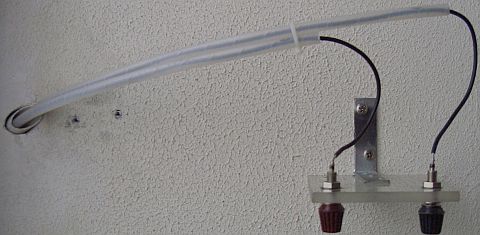
The open line changes impedance as it passes through. An impedance jump occurs, but that is not a problem if the antenna system is adjusted with an antenna tuner.
FINISHING

Spread the "pipes" on the outside to increase the spacing.
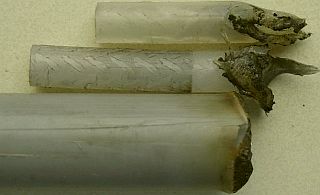


On the outside you have to increase the distance between the pipes by spreading. With more power and during rainy weather or fog, breakdown can take place due to the polluted and then conductive water. You can see the result («fig) in the photo. In fairness it should be mentioned that this happened (as a test) with an antenna that was too short and a lot of power at 160 m, which resulted in an extremely high voltage on the open line.
If you are going to move later, you can pull the tube (fig») out of the hole and fill the gap in the cement joint between the bricks again with cement. No one will see it later..
Two cores of a stripped RG213 cable side by side are just a bit too wide for the plastic pipe. The cross-section of the pipe becomes oval-shaped and then no longer fits in the 16 mm hole. Due to their good insulating properties of about 5 kV, both pieces can be passed through the wall without installation pipe.

De openlijn kunt u binnen in huis voortzetten door van twee coaxkabels de afscherming compleet te verwijderen (fig») en de kale geïsoleerde binnenader met kabelbinders te fixeren. Een ander methode is het naast elkaar (met zadels) monteren van twee kunststof installatie buizen en elke buis voorzien van een zwarte, bruine of geelgroene draad.
 |
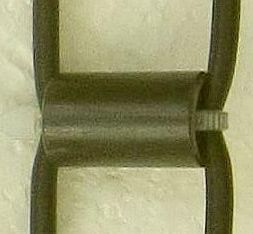 |
 |
You can also make a smooth ribbon line yourself from two wires with spacers and tied together with cable ties .
STATIC DISCHARGE
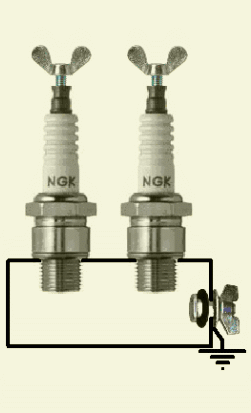

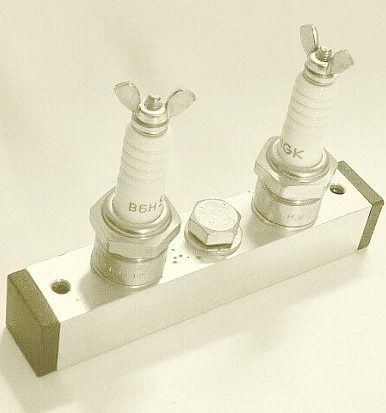
To discharge static, two used spark plugs were mounted in a stainless steel housing as a "discharger". The latter is grounded via a wire to a metal antenna mast. Later, such a system (fig») was offered on eBay.
![]()